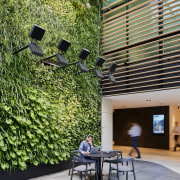Thoughtful intervention transforms poorly organised building into an integrated commercial and retail facility providing occupants with an A Grade experience
By completely reinvigorating internal facilities and external features, Custance Associates has transformed U60 into an attractive and highly functional commercial space that’s attuned to the new generation of office tenants

Some existing buildings seem to function so poorly, it’s hard to imagine what the original design rationale could have been. But it’s also heartening to see what a huge difference can be made by a thoughtful intervention to such a building.
Sitting on the busy East-West bypass between Sydney’s CBD and the inner western suburbs, the 15-year-old Amex building at 60 Union St had some decidedly puzzling design features.
The development consisted of a three-storey terrace building and a seven-storey office tower, connected by a glass atrium roof. Open at both ends, the atrium was essentially a windswept tunnel.
It was also open to the basement level retail below, with a ramp across the void providing only constrained flow between the two buildings.
On top of that, the main entry to the building was almost concealed and opened into an under-sized lobby, while exterior finishes were hard, cold and unfriendly, resulting in little street appeal.

When Amex vacated the premises in 2016, building owners AFIAA tasked Custance Associates Australia with reinvigorating the building to align it with current market needs and demands.
Custance director Greg Prerau says AFIAA wanted an A Grade building that would compete with nearby CBD buildings, while also having its own character.
“We enclosed the atrium with a glazed facade at each end, and included operable louvres so the space was naturally ventilated,” says Prerau.
“The basement level retail was rejigged, and the void covered over with an atrium floor, creating an internal courtyard shared between the buildings.”
This gave space for a cafe at the front of the atrium, while further in is an arrangement of seats and desking for informal tenant or client meetings.
A feature of the atrium is a 9m-high green wall, which promotes a sense of calm and assists with cleaning the air of VOCs for a healthy environment.

More health considerations came with the creation of a state-of-the-art end-of-trip facility in the basement level 2. This provides a large bike storage, 102 lockers and drying cupboards, plus hospitality style changing rooms and showers.
“To increase the street presence and sense of entry, the main corner of the three-storey building was demolished and rebuilt with a grand two-storey entrance opening into a new, much larger lobby,”
Encasing this glazed structure in a custom-designed screen of aluminium tiles adds to its prominence, with the pattern and angles of the tiles carefully considered so as to create a sense of movement without the need for mechanics.
The end result of the changes inside and out is a transformation of the building into a highly attractive, integrated commercial and retail facility that now provides an A Grade experience for occupants.
Credit list
Project
Architect and interior designer
Mechanical engineer:GWA
Quantity surveyor
Fire consultant
Glazing
Paint
Ceiling panels
Feature lighting
Surfaces
Lift services
Developer
Construction company
Electrical engineer
Landscaping
Cladding
Flooring
Wallcovering
General lighting
Public area furniture
Blinds
Story by: Paul Taylor
Photography by: Marcus Clinton; Mark Syke
Home kitchen bathroom commercial design
Commercial Design Trends 35-2C
The world of hotel design is changing, with a move away from bland repetition of a chain’s design template to giving gue...
Read More








